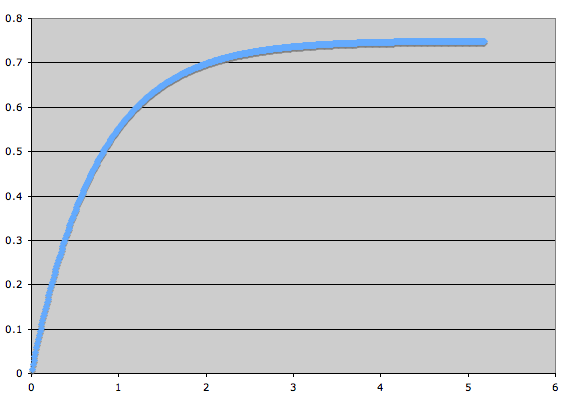Assignments for Monday's class:
Old homework:
- Draw a sketch for the relation between the number substitutions that occurred in evolution and the the percent identity of the two sequences. (I.e. how does the observed similarity change, as more and more substitutions occur?)
- How does this relationship change, if some parts of the sequence are so important that the protein becomes non-functional, if a mutation occurs in these positions (i.e., these parts of the sequence are never observed to undergo any change?
- If substitution were to occur at a rate of 10^-8 per year and per site, how long would it take for two sequences to by less than 50% identical? (do a rough estimate ignoring multiple substitutions and back mutations.)
- If you were to do a realistic calculation and you were to consider a nucleotide sequence, how long would it take to arrive at 20% identity? (tip: how similar are to random sequences that have not been aligned?)
Here is how I envisioned the answers, Jukes Cantor spread sheets are here)
Jukes Cantor relationship (observed difference p versus number of substitutions d) for nucleotides. (A derivation is here).

Brief comments on what is living and what not (class 4)
Slides on inteins
Discussion:
Feedback loops in GAIA - subsystems can evolve by natural selection
Slides on Mutual Aid versus (?) Natural Selection here
What are alternatives to evolution by natural selection?
In biological evolution, what processes might go beyond natural selection?
Do these processes conflict with "Darwinian evolution" or only with the modern synthesis?
- gene transfer
- selfish genetic elements / molecular parasites
- fusion of lineages (e.g., eukaryotes, lichen)
- group selection
- non-random mutations
- directed mutations
- mutationism (big jumps due to mutations, aka Hopeful Monsters)
- genetic drift
- gratuitous complexity / neutral pathways towards complexity
Natural Selection and Evolution
When does "evolution" occur? An
algorithmic approach.
"Darwin's Dangerous Idea" by Daniel C.
Dennett, Chapter on Evolution as algorithm is a reading assignment for
Monday, Sept. 13. [available through WebCT]
What is needed for evolution to occur?
(Note, this is different from stating that this is all that occurs in evolution)
- Offspring not identical to parents
- More offspring than necessary
- Competition for resources, mates => survival of the
fittest.
What processes in biological evolution go beyond inheritance
with variation and selection? (We'll discuss many of the following
later in the semester.)
- Horizontal gene transfer and recombination
- Polyploidization (angiosperm and vertebrate evolution) see here and here
- Fusion and cooperation of organisms (Kefir, lichen, also
the eukaryotic cell)
- Evolution of the holobiont (host + symbionts)
- Targeted mutations (?), genetic memory (?) (see Foster's and Hall's reviews on directed/adaptive mutations; see here for a counterpoint)
- Random genetic drift
- Gratuitous
complexity
- Selfish genes (who/what is the subject of evolution?)
- Parasitism, altruism, gene transfer agents
- Mutationism, hopeful monsters
|
In the unlikely event that we still have time:
Goals class 5:
- Appreciate that without selection for function two sequences would have diverged beyond recognition in a few hundred million years.
- Understand the different meanings of the term evolution ("As in evolution of the universe" vs "Nothing in biology makes sense if not considered in the light of evolution".
- Appreciate the power of natural selection
- Understand that other mechanisms in addition to natural selection might be at play in biological evolution

